This page contains the detailed and easy notes for GCSE CCEA Biodiversty Biology Ecology for revision and understanding Biodiversity.
Banner 1
GCSE CCEA Biology Biodiversity Complete Revision Summary
Biodiversity
Banner 2
Biodiversity
- Communities
- Abiotic Factor
- Biotic Factor
- Adaptations
- Carbon Cycle
- Waste Cycle
- Climate Change
- Biodiversity
- Waste Management
- Land Use
- Deforestation
- Global Warming
- Food Chain
- Pyramids
- Food Production
- Organism – Individual Species
- Population – Groups of similar organisms living in the same area.
- Community – Groups of population living in a defined area
Banner 3
- Ecosystem – Groups of communities with its living and non-living factors
- Biosphere – Groups of different Ecosystem
- Organisms, Populations, and Communities: In a forest, each pine tree is an organism. Together, all the pine trees make up a population. All the plant and animal species in the forest comprise a community.

- Ecosystems: This coastal ecosystem in the southeastern United States includes living organisms and the environment in which they live.

- The Biosphere: Encompasses all the ecosystems on Earth.

Banner 4
ECOSYSTEM
It is a segment of nature consisting of a biological community and its physical environment both interacting and exchanging materials as well as energy. e.g – pond ecosystem.
Ecosystem is the group of communities interacting with the biotic and the abiotic factors.
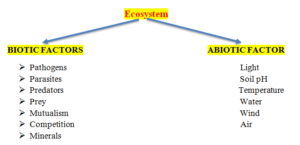
Banner 3
ABIOTIC FACTORS
Non-living substances and factors of an ecosystem. E.g temperature, light, wind.
Most of the abiotic factors affects photosynthesis which affects the producers which inturn affect the complete food chain.
Light – Less light limits the photosynthesis and affect the entire food chain Plant in low light have broader leaves to increase surface area for absorption.
Water – Water is required for growth. Less water limits the photosynthesis and affect the entire food chain
pH – The low pH makes the soil acidic and limits the growth of plants and affect the entire food chain
Temperature – Temperature also limits the rate of photosynthesis which affects the food chain
Oxygen – The oxygen is required for the growth of the plant. In low levels of oxygen the organisms cannot survive
Carbon Dioxide – Carbon dioxide is required for growth. Less water limits the photosynthesis and affect the entire food chain.
Wind – Plants growing in high wind adapt different shapes. Wind also affects the rate of transpiration.
BIOTIC FACTORS
Constitute all the living members of an ecosystem. E.g Producers, Consumers, Decomposers.
FOOD – Food availability helps the species to grow and reproduce.
PATHOGEN – A pathogen can cause infectious disease d affect the growth of the population and can also wipe the whole population
PARASITES – Parasites can limit the growth of the host and affect the • population of the community.
COMPETITION – Increasing competition can affect the growth of the population and can outcome the individual of a population
PREDATORS – Increase in predation can decrease the population of the prey.
INTERDEPENDENCE
- One species is dependent on other. Like plants are dependent on insects for seed dispersal and pollination.
- Herbivores are dependent on plants for food.
- If one species is removed it affect the other species.
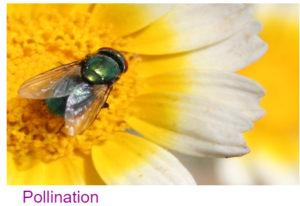
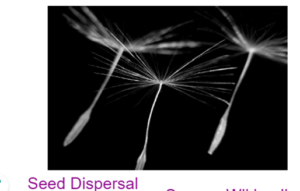
Biodiversity
[download_after_email id=”9027″]
COMPETITION IN PLANTS AND ANIMALS
| INTERSPECIFIC COMPETION | INTRASPECIFIFC COMPETION |
| It is the competition between the members of different species. | It is the competition between the members of the same species. |
Food Territory Resources | Food Territory Mating |
| It leads to the movement of species to a new place, adaptation or extinction |
Banner 4
ADAPTATIONS
Special Features that give the organisms the survival advantage and helps the organism to survive in the extreme conditions.
PLANT REQUIRMENTS
- Water, space, minerals, carbon dioxide for photosynthesis
- Oxygen for respiration.
- Major adaptations they have make them successful in getting these components from the environment
ANIMAL REQUIREMENTS
- Food to survive
- Oxygen for respiration
- Mate to reproduce.
Adaptations can be structural, behavioural and functional adaptations.
PLANT ADAPTIONS
| PLANT CHALLENGES | PLANT ADAPTATIONS | EXAMPLE |
| Water loss and dry conditions in desert | Small leaves; Leaves reduced to spines to decreases the surface area for water less. Extensive root system to absorb maximum water and succulent stems to store water. Plants are also covered with waxy cuticle to limit water loss | Cactus where leaves are reduced to spines Marram grass which has curled leaves and sunken stomata to trap moist air to limit water loss. |
| Lots of rain and water with less light in rainforest | Leaves are broad to trap maximum sunlight. They have thin cuticle | Epiphytes like Lianas |
| Plant growing in low nitrogen soils. | The plants trap insect and digest them to fulfil their nitrogen and mineral requirements | Carnivores plant like Venus Flytrap |
| Plants prone to insect attack | These plants secrete chemicals like alkaloids or tannins to repel insect | Tobacco produced Nicotine. |
| Aquatic Plants growing in excess water and less light | Flexible stem to withstand water current. Broad leaves to absorb maximum light. They have hair spaces in leaves | Water Lillies |
ANIMAL ADAPTATIONS
| DESERT ANIMALS Hot, dry conditions | ARCTIC ANIMALS Extreme cold | |
| Structural | They have large ears to give off maximum heat. They are small with large surface area to volume ratio. | They have small surface area to volume ratio to prevent heat loss. They have fur or thick fat deposit to provide insulation. White fur also comouflage with the ice. |
| Behavioural | They are more active during early morning and evening. When it is too hot or too cold they rest in burrows. | Polar bears form big dens and are strong swimmers and can swim through ice. |
| Functional | Produce very concentrated or no urine. | The fur or the coat change colours in summer and winters. |
EXTREMOPHILES
| EXTREME TEMPERATURE | EXTREME SALT |
| They have enzymes that work at high temperature and do not get denatured. | They have salt glands to expel excess salt. |
| For extreme cold they have antifreeze. | They also have adaptations in the cytoplasm so that they cannot gain or loose water. |
STUDYING COMMUNITIES
Quadrat Method – Random squares are placed at different point and the species within that squares are counted.
Transect Method – A line is placed and the species that are within this line or few cm above or below this line are counted and recorded.
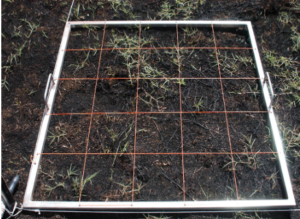
Sample Size – The sample to be take for observation.
Mean – It is the statistical value calculate by adding all the values divided by total number of values.
Median – It is the middle value of the data.
Mode – The value that has the greatest frequency.
Range: It is the highest value take away the lowest value.
TROPHIC LEVELS
Producers: They produce their own food as they can photosynthesize and converts Sun’s energy to chemical energy.
Primary Consumers – They are herbivores which feeds on plants.
Secondary Consumers – They are carnivores or omnivores which feeds on herbivores.
Tertiary Consumers – They are at the top of food chain
Decomposers – Feed on dead and decay matter.
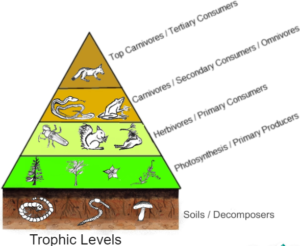
Baneer 6
FOOD CHAINS
- It is the relationship of who eats whom.
- At each level there is a loss of energy and only 10% is transferred to the next trophic level so the food chains are mostly restricted to 3-4 tropic levels.
- Sun is the principal source of energy driving the whole food chain.
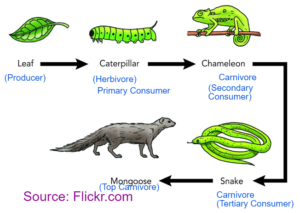
PREDATOR- PREY RELATIONSHIP
- Prey increases
- Predator increases
- Prey Decreases
- Predator decreases
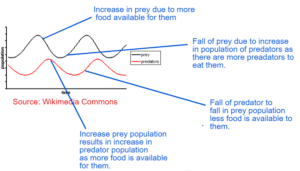
PYRAMIDS OF BIOMASS
- Graphical representation of the mass of the living organism at each level.
- It is upright as :-
- Not all the biomass is eaten by the next trophic level
- Some of the biomass is lost as energy at each trophic level.
- Some of the biomass is lost as waste product at the trophic level.
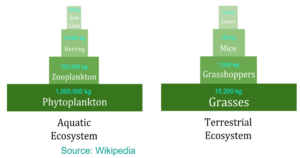
Biomass is the mass of the materials contained in the living organisms.
PYRAMIDS OF NUMBERS
- It is the graphical representation of the number of organisms at each trophic level.
- It can be upright, inverted or upside down.
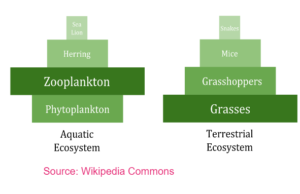
ENERGY TRANSFER PYRAMID
- It is the graphical representation of energy at each trophic level.
- Energy Lost at Each trophic Levels
- a) Energy is required for movement, growth and repair
- b) Energy is lost in digestion
- c) Energy is lost in maintaining constant body temperature
- d) Energy is lost as heat during respiration.
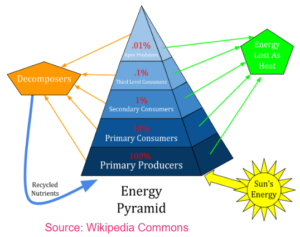
CYCLING OF MATERIALS
- Decomposers play an important role in material recycling
- Decomposers feeds on dead and decay matter. They break the organic matter into simple components and return them to soil.
- The products carbon dioxide into the atmosphere by the process of decomposition.
- Bacteria and Fungi
Proteins in the dead and decay matter is converted into nitrates and returned to soil.
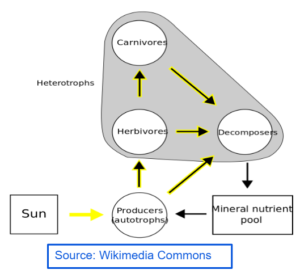
Banner 7
WATER CYCLE
Evaporation – water is evaporated from the water bodies like sea, lakes etc and form water vapours.
Transpiration – The water vapours are also lost from the surface of the plants.
Respiration – Respiration produced water vapour and it is lost in the form of water vapours
Condensation – The water vapour from all the above source cools and condense to form clouds.
Precipitation – When clouds get full the fall of as rain and the cycle continues.
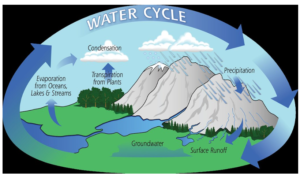
CARBON CYCLE
Photosynthesis – It is the process by which green plants take in carbon dioxide from the
Respiration – The carbon dioxide is returned back to the atmosphere
Combustion – The fuel burns releasing carbon dioxide into the atmosphere
Decomposition – It is the process by which decomposer decay dead material and release carbon dioxide into the atmosphere
Fosslization – Dead Plants and Animals form fossil fuels which burns to release carbon dioxide into the atmosphere
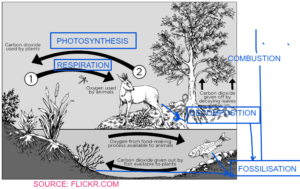
Banner 8
DECOMPOSITION
They are the microorganisms that breaks the dead and decay materials into simpler components. They are very important as they return the nutrients and minerals back into the atmosphere
Condition required for decay
- a) Oxygen
- b) Warm Conditions
- c) Moist Conditions
Decay process forms methane which can be used as fuel.
Decay process also produce compost which can be used as a manure.
Plants
Animals
DECOMPOSERS
Breaks the dead and decaying plants and animals into simple components which are recycled in the atmosphere.
BIODIVERSITY
It is the measure of number of difference species in an area. Greater the biodiversity more stable is the ecosystem and less dependency on other organisms.
Uses of Biodiversity
- It is required to make the ecological balance as one species is dependent on the other.
- It is required for medicine like medicinal plants.
- It is required for agriculture and poultry.
- It is required to maintain ecotourism.
- Species are dependent on one another. So if one species is affected it can affect the entire population.
Threats to Biodiversity: All factors are interconnected
- Deforestation : Rapid population growth causing clearing of forests and making industries and home causing climate change and global warming_
- Population Growth – Leading to deforestation, monoculture
- Agriculture – Increasing food demand is causing monoculture causing reduction in gene pool.
- Industrialization – Due to increasing population size
AIR POLLUTION
ACID RAIN
Formation
Sulphur and nitrogen present in fossil fuels forms carbon dioxide and sulphur dioxide by combustion.
Carbon dioxide and sulphur dioxide combine with rainwater forming nitric acid and sulphuric acid and falls as acid rain.
Effects
- a) Makes soil acidic
- b) Damage trees and aquatic life
- c) Corrossion of building
- d) Errodes building and rocks
Prevention
- a) Decrease in use of fossil fuels.
- b) Treat the waste to remove nitrogen and sulphur before evolving.
- c) Use alternative source of energy.
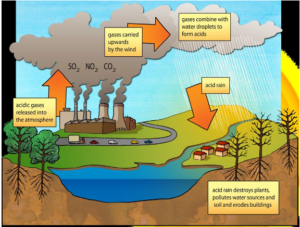
Banner 9
SMOG
Smog is opaque or dark fog having condensed water vapours, dust, smoke and gases.
- Mixture of nitrogen dioxide and sulphur dioxide particulates in the lower atmosphere.
- Depletes ozones layer, cause dimming effect.
- Lowers the Earth’s temperature
- If inhaled causes damage to lungs, respiratory problems and cardiovascular diseases.
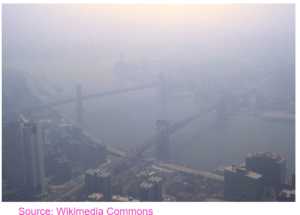
WATER POLLUTION
- Fertilizers washed away
- Increases the nutrient content of water causing algal bloom
ALGAL BLOOM
- Forms green layer, block sunlight
- Death of plants, decreasing oxygen in water. Death of other species.
- Decomposers increasing further decreasing oxygen.
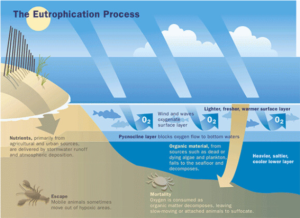
Banner 10
BIOMAGNIFICATION
It is increase in the concentration of a persistent chemical with the rise in trophic level. As the toxic products go along the food chain the concentration of the toxic chemicals increases.
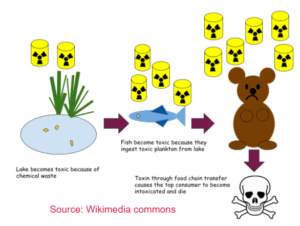
LAND POLLUTION
- Solid Waste
- Plastic, metals and other man made chemicals fills the landfill sites
- Chemicals -Toxic Chemicals come from industries and agricultures sites.
- Agriculture Waste – Spray of insecticides, pesticides and weedicide contributes to land pollution.
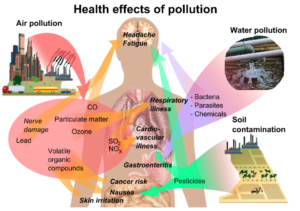
DEFORESTATION
Causes
- Rapid industrialization, population growth and urbanization
- Clearing of forests form making home and industries. Increase in agriculture to grow food and fuel crops.
Effects
- a) Increase in carbon dioxide levels causing global warming and climate change.
- b) Loss of biodiversity by causing habitat destruction
- c) Causing extinction of species.
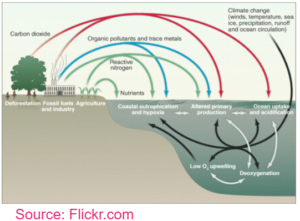
PEAT BOG DESTRUCTION
What is Peat ?
- It is a plant material that is not decayed due to acidic conditions.
- Forms peatlands and peat bogs and are massive storehouse of carbon and host many organisms.
Uses of Peat
- a) Unique carbon store
- b) Habitat for many microorganism, plants and animals that can survive in acidic conditions.
- c) Used as fuel
Effect of Peat Bog Reduction
- Causes loss of biodiversity.
- Takes millions of years to form.
GREENHOUSE EFFECT
It is warming effect found in green house by allowing solar radiations to pass in but preventing long wave heat radiations to pass out due to glass panes, water vapours and carbon dioxide.
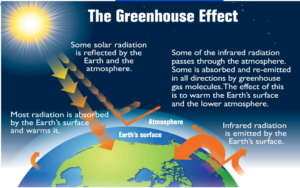
GLOBAL WARMING
Rise in mean temperature of the earth. It is due to the excess amount of green house gases present in the atmosphere
- Climate Change
- Habitat Loss
- Floods
- Change in Migration of Birds
- Change in distribution of plants and animals
- Change in seasonal pattern
- Loss of Biodiversity causing extinction of species.
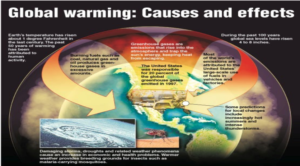
MAINTAINING BIODIVERSITY
In situ Conservation
- It is the protection of endangered species in their own natural habitat like making national parks, wildlife sanctuary and making biosphere reserves.
- Breeding programmes are also carried in these areas to increase the population of endangered species.
Ex Situ Conservation
- Preserving the biodiversity outside their natural habitat like
- Zoos, botanical garden, tissue culture, seed banks and gene bank.
Preventing Deforestation and Combustion
- Preventing deforestation and planting more trees can reduce the carbon emissions and can prevent global warming and climate change
- Recycling and using alternative sources of energy
- Recycling and using alternative sources of energy can reduce the dependency on fossil fuels causing reducing the carbon emissions preventing global warming, climate change and its effects.
Banner 11
FOOD SECURITY
What is Food Security ?
Growing sufficient healthy food to feed the population and accessibility of the population to grow or buy the healthy food.
Factors Affecting Food Security
- a) Population Growth
- b) Inclination toward unhealthy and easy to cook foods
- c) Spread of Disease
- d) Pest and Insect attack to the crop.
- e) Climate Change
- f) Acid Rain and Pollution
- g) Water Pollution
- h) Increase in cost of agricultural supplies
- i) Food versus Fuel Issue
EFFICIENT FOOD PRODUCTION
- Increasing more plant based products
- When plant based products are used they have the highest biomass and maximum energy as they are at the initial level of food chain.
- Plant based product reduces the dependency on animal products.
- Reducing the level of food chain
- At each trophic level, there is energy loss.
- So if the food chain levels are reduced maximum energy and biomass can be obtained.
Intensive Farming
In intensive farming the animals are grown to limit energy loss and produce maximum biomass by
- a) Restricting Movement – By restricting movement energy loss in movement is prevented.
- b) Rearing them at constant temperature – Energy loss in maintaining body temperature is prevented.
- c) Giving them easy to digest food – It reduced energy loss in digestion.
- d) Giving them protein rich diet – It helps to grow more biomass
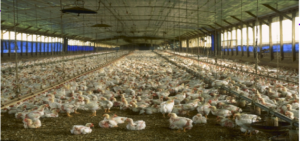
SUSTAINABLE FOOD PRODUCTION
- a) Use of genetic engineering to increase the yield of the crops and making more disease resistant and high yield variety.
- b) Use of microorganisms for food production
Mycoprotein are the proteins source from fungi. It is excellent food source and is sustainable grown in fermenter.
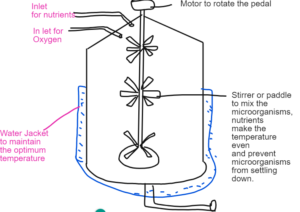
Banner 11
KEY TERMS
- a) Communities – It is an assemblage of populations of different species of plants, animals, bacteria and fungi which live in a particular area and interact with one another through competition, predation, mutualism, etc.
- b) Ecosystem – It is a segment of nature consisting of a biological community and its physical environment both interacting and exchanging materials as well as energy. e.g – pond ecosystem
- c) Interdependence – refers to a situation in which both species require the action of the other to function.
- d) Stable Communities – A stable communities are those is in which the size of populations of all species remains comparatively constant over time.
- e) Abiotic Factor – Non-living substances and factors of an ecosystem. E.g temperature, light, wind.
- f) Biotic Factor – Constitute all the living members of an ecosystem. E.g Producers, Consumers, Decomposers.
- g) Predator – It captures, kill and on another organisms called prey. Ex -tiger
- h) Prey – an animal hunted or seized to eat, especially from a carnivorous animal
- i) Pathogen – a bacterium, virus or other micro-organism that can cause disease.
- j) Parasite – it feeds on another organism called host. The parasite spends a part or whole of its life on or in the body of the host.
- k) Competition – it is a rivalry between two or more organisms for obtaining the same resources.
- l) Abundance – The number of organisms in a population, combining intensity and prevalence.
- m) Distribution – spatial relationship between individuals in a population.
- n) Quadrat – A quadrant is a sampling unit used for the quantitative study of the plant community. Can be rectangular or circular. Used to measure the coverage and abundance of plants or animals
- o) Sample Size – The sample to be take for observation.
- p) Mean – It is the statistical value calculate by adding all the values divided by total number of values.
- q) Range: It is the highest value take away the lowest value.
- s) Median – It is the middle value of the data.
- t) Mode – The value that has the greatest frequency.
- u) Transect – A transect is a long rectangular sample. It is used to study variation in vegetation.
- v) Adaptation – Changes in the form or behavior of an organism during its life as a response to environmental stimuli.
- w) Biomass – mass of the individuals per unit area
- x) Producers – They are Photosynthetic or autotrophic plants which are able to synthesize organic food from inorganic raw materials with the help of solar radiations.
- a) Precipitation – Precipitation includes rain, snow, and hail.
- b) Condensation – gas changing to a liquid.
- c) Evaporation – liquid’s surface changing to a gas.
- d) Transpiration – water vapor being released from plants and soil.
- g) Combustion – It occurs when any organic material is reacted (burned) in the presence of oxygen to give off the products of carbon dioxide and water and Energy
- h) Decomposition – It is the process of breaking down of a substance/waste biomass into its constituent parts by decomposers(bacteria, fungi)
- j) Biodiversity – It refers to all aspects of variety in the living world.
- k) Acid Rain – It is rainfall and other forms of precipitation with a pH of less than 5.
- l) Smog – Smog is opaque or dark fog having condensed water vapours, dust, smoke and gases.
- m) Eutrophication – It is excessive growth of algae, plants and animals in water bodies due to the nutrient enrichment particularly with nitrogen and phosphorous.
- n) Biomagnification – It is increase in the concentration of a persistent chemical with the rise in trophic level. Eg organochlorine like DDT
- o) Global Warming – Rise in mean temperature of the earth. It is due to the excess amount of green house gases present in the atmosphere
- p) Greenhouse Effect – It is warming effect found in green house by allowing solar radiations to pass in but preventing long wave heat radiations to pass out due to glass panes, water vapours and carbon dioxide.
- q) Trophic Level – Trophic level is a step or division of food chain which is characterized by the method of obtaining its food.
- r) Pyramids of Biomass – graphic representation of biomass present sequence-wise per unit area of different trophic levels with producers at the base and top carnivore kept at the tip.
- s) Pyramids of Number – graphic representation of number of individuals per unit area of various trophic levels step-wise with producers at the base and top carnivore kept at the tip.
- t) Food Security – Growing sufficient healthy food to feed the population and accessibility of the population to grow or buy the healthy food. All people have access to sufficient, safe and nutritious food that meets their dietary preferences and dietary needs for an active and healthy life.
- u) Fermenter – An organism that causes fermentation.
- v) Biotechnology – living organisms are used to produce useful products and chemicals or to perform an industrial task. It is mainly used in agriculture, food science and medicine.
w) Mycoprotein – Mycoprotein is a type of unicellular protein derived from fungi. It is excellent food source and is sustainable grown in fermenter
Banner 12
Disclaimer:
I have tried my level best to cover the maximum of your specification. But this is not the alternative to the textbook. You should cover the specification or the textbook thoroughly. This is the quick revision to help you cover the gist of everything. In case you spot any errors then do let us know and we will rectify it.
References:
BBC Bitesize
Wikipedia
Wikimedia Commons
Image Source:
Wikipedia
Wikimedia
Commons
Flickr
Pixabay
Make sure you have watched the above videos and are familiar with the key definations before trying these questions. It is also good to time yourself while doing these questions so that you can work on the speed as well
Adaption Interdependence And Competition
Organising An Ecosystem
- Organisation of an Ecosystem 1 MS
- Organisation of an Ecosystem 1 QP
- Organisation of an Ecosystem 2 MS
- Organisation of an Ecosystem 2 QP
- Organisation of an Ecosystem 3 MS
- Organisation of an Ecosystem 3 QP
Biodiversity and the Ecosystem
- Biodiversity & Effect of Humans on Ecosystems 1 MS
- Biodiversity & Effect of Humans on Ecosystems 1 QP
- Biodiversity & Effect of Humans on Ecosystems 2 MS
- Biodiversity & Effect of Humans on Ecosystems 2 QP
- Biodiversity & Effect of Humans on Ecosystems 3 MS
- Biodiversity & Effect of Humans on Ecosystems 3 QP
- Food Production 1 MS
- Food Production 1 QP
- Food Production 2 MS
- Food Production 2 QP
- Food Production 3 MS
- Food Production 3 QP
- Trophic Levels in an Ecosystem 1 MS
- Trophic Levels in an Ecosystem 1 QP
- Trophic Levels in an Ecosystem 2 MS
- Trophic Levels in an Ecosystem 2 QP
- Trophic Levels in an Ecosystem 3 MS
- Trophic Levels in an Ecosystem 3 Q
